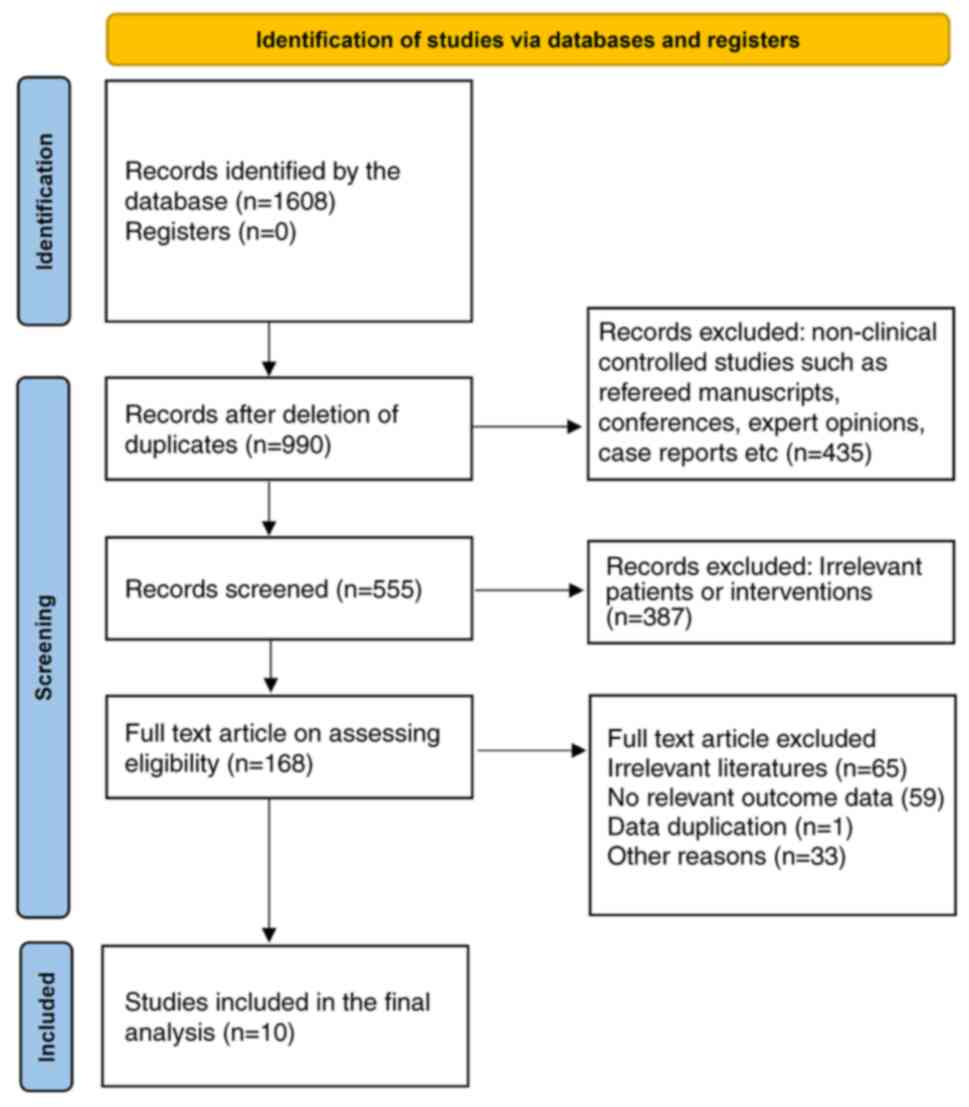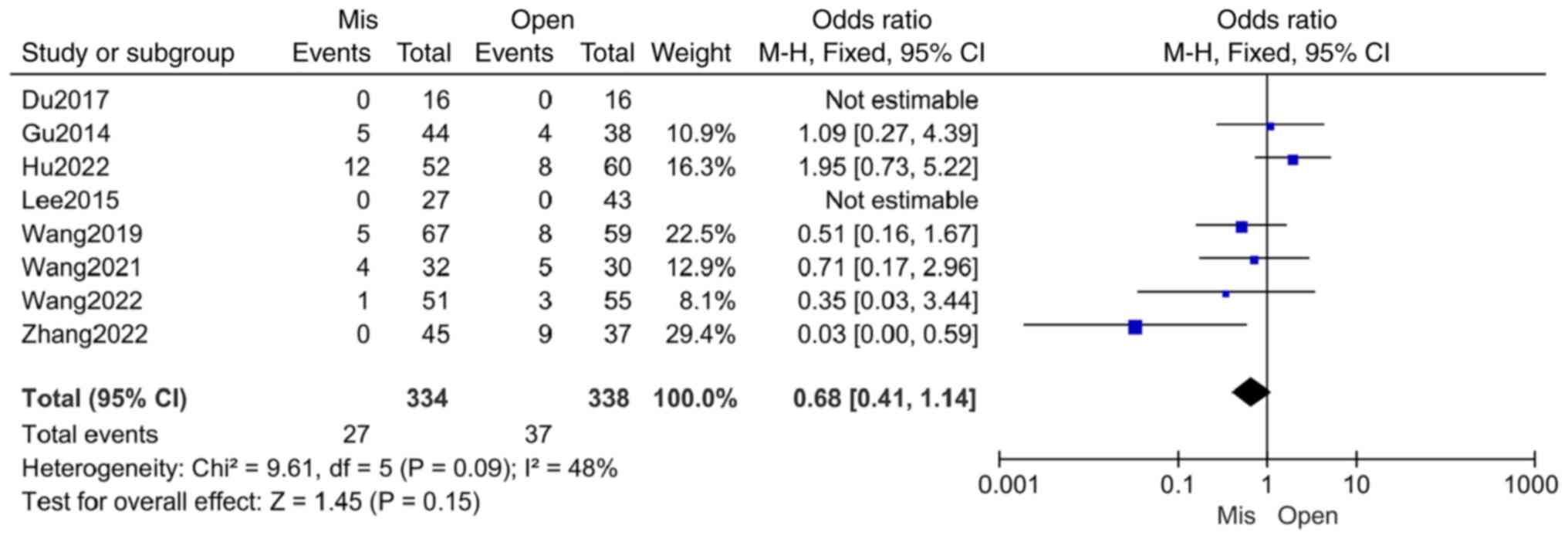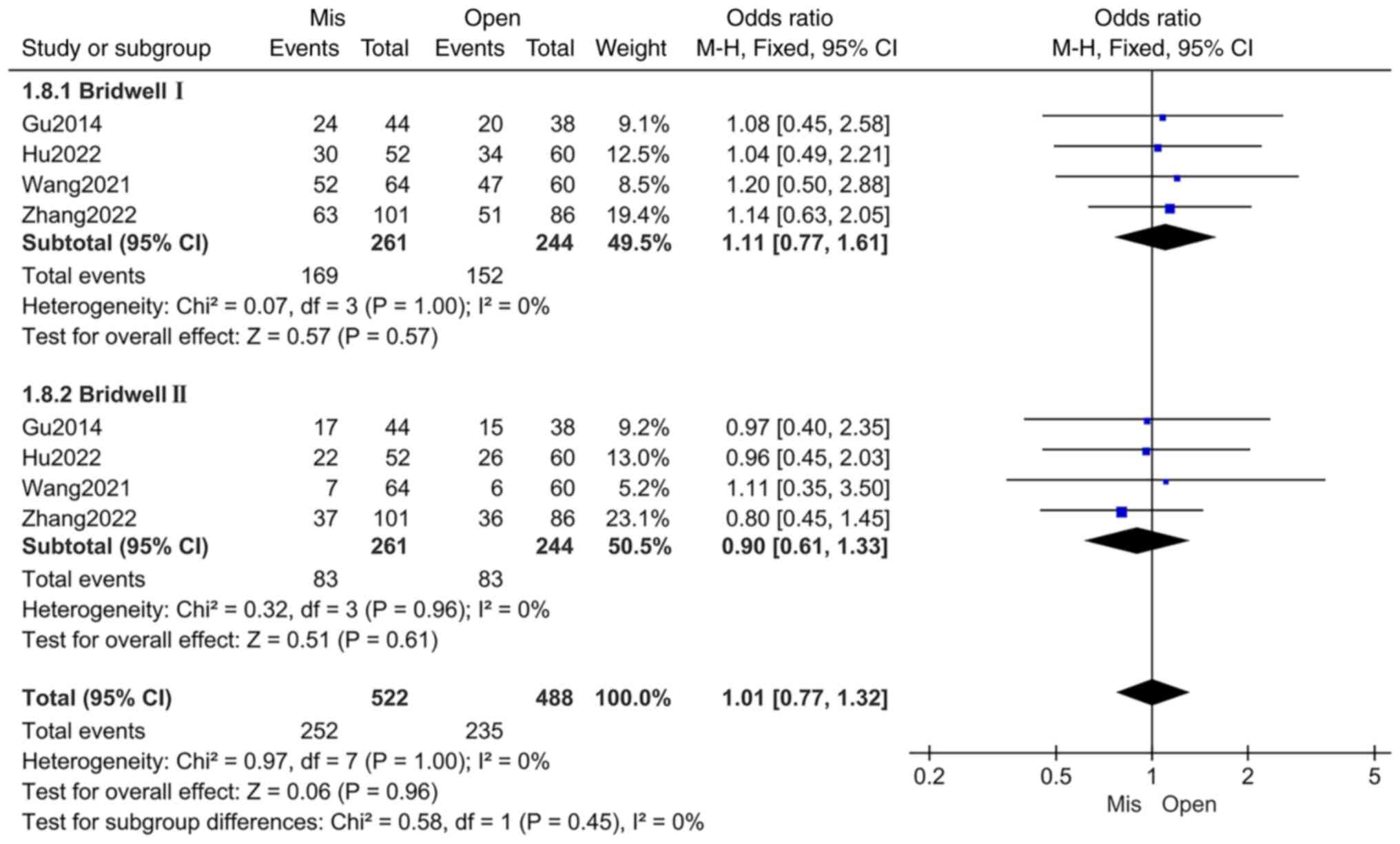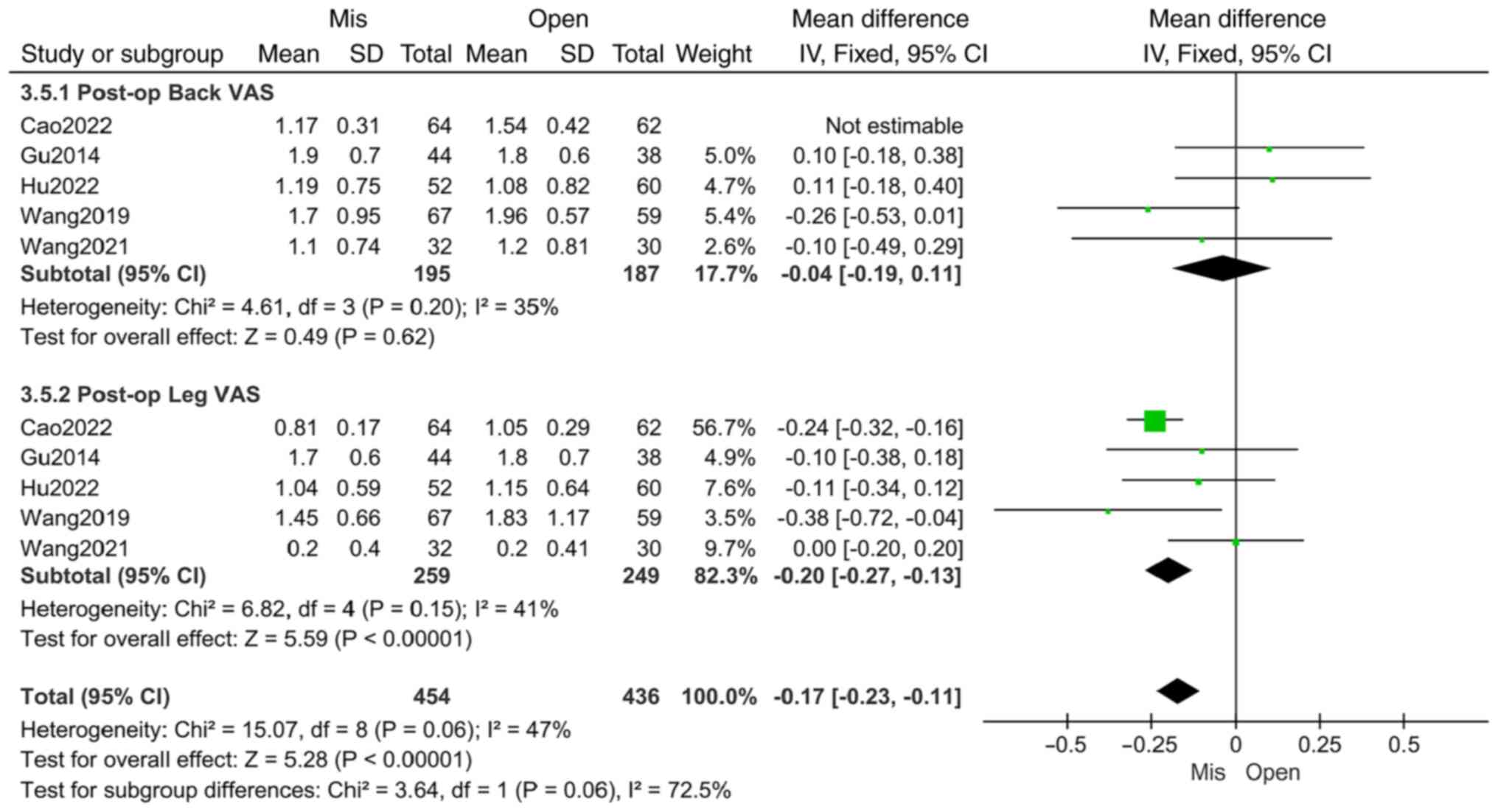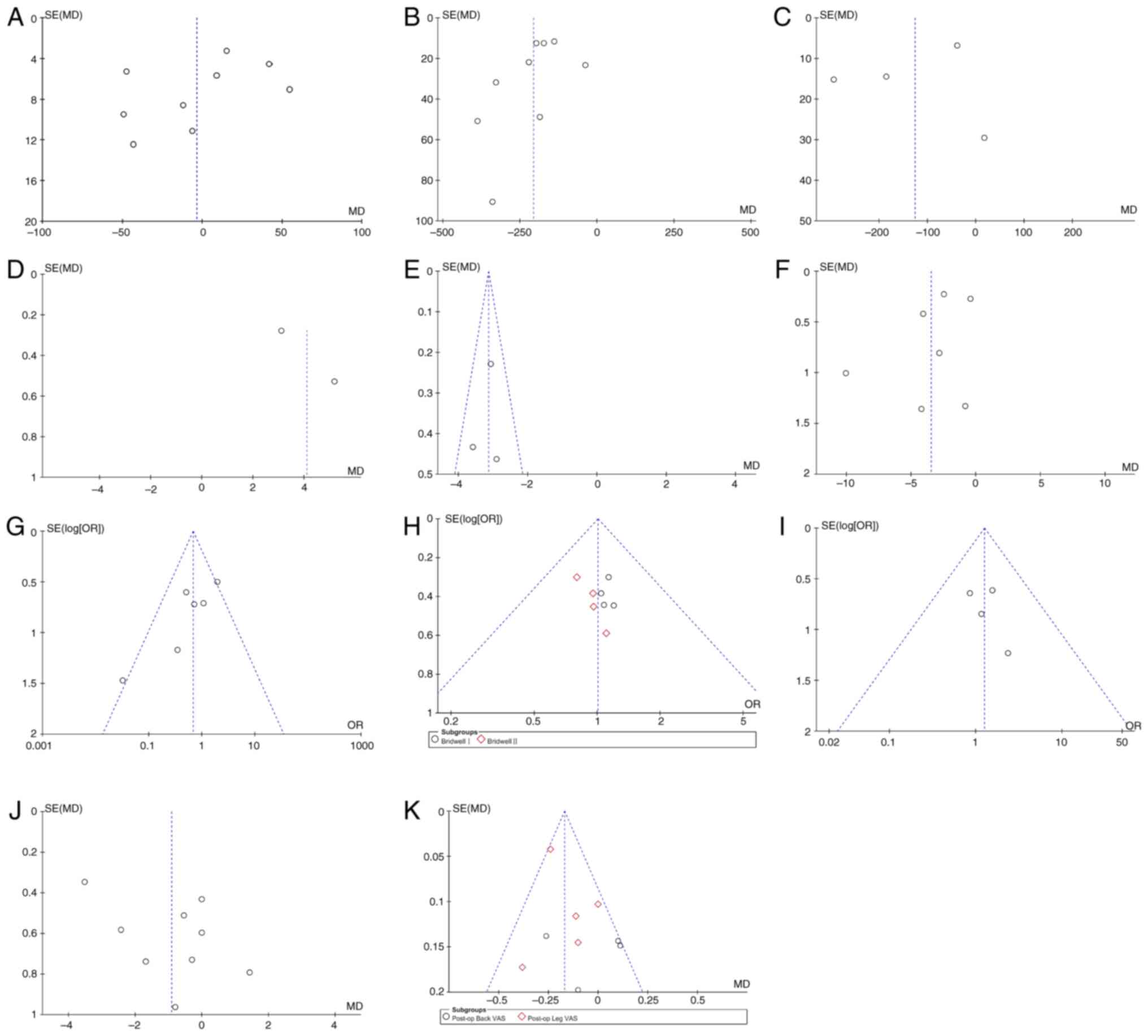|
1
|
Machino M, Nakashima H, Ito K, Tsushima M,
Ando K, Kobayashi K and Imagama S: Influence of age and gender on
intervertebral disk degeneration and height in the thoracolumbar
spine. Spine Surg Relat Res. 6:379–387. 2021.PubMed/NCBI View Article : Google Scholar
|
|
2
|
Patel J, Osburn I, Wanaselja A and Nobles
R: Optimal treatment for lumbar spinal stenosis: An update. Curr
Opin Anaesthesiol. 30:598–603. 2017.PubMed/NCBI View Article : Google Scholar
|
|
3
|
Boucher HH: A method of spinal fusion. J
Bone Joint Surg Br. 41-B:248–259. 1959.PubMed/NCBI View Article : Google Scholar
|
|
4
|
Zhang YW, Deng L, Zhang XX, Yu XL, Ai ZZ,
Mei YX, He F, Yu H, Zhang L, Xiao X, et al: Three-dimensional
printing-assisted cervical anterior bilateral pedicle screw
fixation of artificial vertebral body for cervical tuberculosis.
World Neurosurg. 127:25–30. 2019.PubMed/NCBI View Article : Google Scholar
|
|
5
|
Zhang YW, Zeng T, Gao WC, Xiao X, Xiao Y,
Chen X, Zhang SL and Deng L: Progress of the anterior
transpedicular screw in lower cervical spine: A review. Med Sci
Monit. 25:6281–6290. 2019.PubMed/NCBI View Article : Google Scholar
|
|
6
|
Harms J and Rolinger H: A one-stager
procedure in operative treatment of spondylolistheses: Dorsal
traction-reposition and anterior fusion (author's transl). Z Orthop
Ihre Grenzgeb. 120:343–347. 1982.PubMed/NCBI View Article : Google Scholar : (In German).
|
|
7
|
Reid PC, Morr S and Kaiser MG: State of
the union: A review of lumbar fusion indications and techniques for
degenerative spine disease. J Neurosurg Spine. 31:1–14.
2019.PubMed/NCBI View Article : Google Scholar
|
|
8
|
Kumaran Y, Shah A, Katragadda A,
Padgaonkar A, Zavatsky J, McGuire R, Serhan H, Elgafy H and Goel
VK: Iatrogenic muscle damage in transforaminal lumbar interbody
fusion and adjacent segment degeneration: A comparative finite
element analysis of open and minimally invasive surgeries. Eur
Spine J. 30:2622–2630. 2021.PubMed/NCBI View Article : Google Scholar
|
|
9
|
Foley KT and Lefkowitz MA: Advances in
minimally invasive spine surgery. Clin Neurosurg. 49:499–517.
2002.PubMed/NCBI
|
|
10
|
Bovonratwet P, Samuel AM, Mok JK, Vaishnav
AS, Morse KW, Song J, Steinhaus ME, Jordan YJ, Gang CH and Qureshi
SA: Minimally invasive lumbar decompression versus minimally
invasive transforaminal lumbar interbody fusion for treatment of
low-grade lumbar degenerative spondylolisthesis. Spine (Phila Pa
1976). 47:1505–1514. 2022.PubMed/NCBI View Article : Google Scholar
|
|
11
|
Garg B and Mehta N: Minimally invasive
transforaminal lumbar interbody fusion (MI-TLIF): A review of
indications, technique, results and complications. J Clin Orthop
Trauma. 10 (Suppl 1):S156–S162. 2019.PubMed/NCBI View Article : Google Scholar
|
|
12
|
Mobbs RJ, Phan K, Malham G, Seex K and Rao
PJ: Lumbar interbody fusion: Techniques, indications and comparison
of interbody fusion options including PLIF, TLIF, MI-TLIF,
OLIF/ATP, LLIF and ALIF. J Spine Surg. 1:2–18. 2015.PubMed/NCBI View Article : Google Scholar
|
|
13
|
Jover-Mendiola AD, Lopez-Prats FA,
Lizaur-Utrilla A and Vizcaya-Moreno MF: Patient-reported outcomes
of minimally invasive versus open transforaminal lumbar interbody
fusion for degenerative lumbar disc disease: A prospective
comparative cohort study. Clin Orthop Surg. 15:257–264.
2023.PubMed/NCBI View Article : Google Scholar
|
|
14
|
Xue J, Song Y, Liu H, Liu L, Li T and Gong
Q: Minimally invasive versus open transforaminal lumbar interbody
fusion for single segmental lumbar disc herniation: A
meta-analysis. J Back Musculoskelet Rehabil. 35:505–516.
2022.PubMed/NCBI View Article : Google Scholar
|
|
15
|
Cao Y, Li X, Chen ZG, Li LD and Lv SJ:
Minimally invasive transforaminal approach and conventional
transforaminal approach for lumbar fusion treatment. J Nantong Univ
(Med Sci). 42:544–547. 2022.(In Chinese).
|
|
16
|
Du YB, Zhang ZD, Liu YM, Wang SS and Ma L:
Comparison of effects between MIS-TLIF and TLIF in the treatment of
L4 ~ S1 lumbar stenosis. J Clin Orthop. 20:289–292. 2017.(In
Chinese).
|
|
17
|
Gu G, Zhang H, Fan G, He S, Cai X, Shen X,
Guan X and Zhou X: Comparison of minimally invasive versus open
transforaminal lumbar interbody fusion in two-level degenerative
lumbar disease. Int Orthop. 38:817–824. 2014.PubMed/NCBI View Article : Google Scholar
|
|
18
|
Hu W, Yang G, Wang H, Wu X, Ma H, Zhang K
and Gao Y: Which is better in clinical and radiological outcomes
for lumbar degenerative disease of two segments: MIS-TLIF or
OPEN-TLIF? J Pers Med. 12(1977)2022.PubMed/NCBI View Article : Google Scholar
|
|
19
|
Lee WC, Park JY, Kim KH, Kuh SU, Chin DK,
Kim KS and Cho YE: Minimally invasive transforaminal lumbar
interbody fusion in multilevel: Comparison with conventional
transforaminal interbody fusion. World Neurosurg. 85:236–243.
2016.PubMed/NCBI View Article : Google Scholar
|
|
20
|
Modi HN and Shrestha U: Comparison of
clinical outcome and radiologic parameters in open TLIF versus
MIS-TLIF in single- or double-level lumbar surgeries. Int J Spine
Surg. 15:962–970. 2021.PubMed/NCBI View
Article : Google Scholar
|
|
21
|
Wang L: The Clinical Outcomes Comparison
Between Minimally Invasive (Zista Channel) and Open Surgery for the
Treatment of Multi-Level Lumbar Degenerative Disease. Dalian Med
Univ. 2019.(In Chinese).
|
|
22
|
Wang X, Liu Y, Du Y, Qi J, Li C, Zheng K
and Yu X: Clinical outcomes of minimally invasive transforaminal
lumbar interbody fusion fordouble-segment lumbar spinal stenosis at
mid- and long-term follow-up. J Pract Med. 37:149–153. 2021.(In
Chinese).
|
|
23
|
Wang HH, Liu J, Xu YY, Zhang Y, Sun Y and
Wang GH: Short and medium term efficacy of microscope-assisted
MIS-TLIF versus open-TLIF for two-segment lumbar spinal stenosis. J
Pract Med. 38:1373–1377. 2022.(In Chinese).
|
|
24
|
Zhang Y, Zhou T, Gu Y, Che W, Zhang L and
Wang Y: Contralateral bridge fixation of freehand minimally
invasive pedicle screws combined with unilateral MIS-TLIF vs. open
TLIF in the treatment of multi-segmental lumbar degenerative
diseases: A five years retrospective study and finite element
analysis. Front Surg. 9(1049260)2022.PubMed/NCBI View Article : Google Scholar
|
|
25
|
Stang A: Critical evaluation of the
Newcastle-Ottawa scale for the assessment of the quality of
nonrandomized studies in meta-analyses. Eur J Epidemiol.
25:603–605. 2010.PubMed/NCBI View Article : Google Scholar
|
|
26
|
Bridwell KH, Lenke LG, McEnery KW, Baldus
C and Blanke K: Anterior fresh frozen structural allografts in the
thoracic and lumbar spine. Do they work if combined with posterior
fusion and instrumentation in adult patients with kyphosis or
anterior column defects? Spine (Phila Pa 1976). 20:1410–1418.
1995.PubMed/NCBI
|
|
27
|
Kang YN, Ho YW, Chu W, Chou WS and Cheng
SH: Effects and safety of lumbar fusion techniques in lumbar
spondylolisthesis: A network meta-analysis of randomized controlled
trials. Global Spine J. 12:493–502. 2022.PubMed/NCBI View Article : Google Scholar
|
|
28
|
Cheng X, Zhang K, Sun X, Zhao C, Li H, Ni
B and Zhao J: Clinical and radiographic outcomes of bilateral
decompression via a unilateral approach with transforaminal lumbar
interbody fusion for degenerative lumbar spondylolisthesis with
stenosis. Spine J. 17:1127–1133. 2017.PubMed/NCBI View Article : Google Scholar
|
|
29
|
Parrish JM, Jenkins NW, Brundage TS,
Hrynewycz NM, Podnar J, Buvanendran A and Singh K: Outpatient
minimally invasive lumbar fusion using multimodal analgesic
management in the ambulatory surgery setting. Int J Spine Surg.
14:970–981. 2020.PubMed/NCBI View
Article : Google Scholar
|
|
30
|
Ge DH, Stekas ND, Varlotta CG, Fischer CR,
Petrizzo A, Protopsaltis TS, Passias PG, Errico TJ and Buckland AJ:
comparative analysis of two transforaminal lumbar interbody fusion
techniques: Open TLIF versus wiltse MIS TLIF. Spine (Phila Pa
1976). 44:E555–E560. 2019.PubMed/NCBI View Article : Google Scholar
|
|
31
|
Garcia D, Sousa-Pinto B, De Biase G,
Ruiz-Garcia H, Akinduro OO, Dholakia R, Borah B, Fox WC, Nottmeier
E, Deen HG, et al: Minimally invasive transforaminal lumbar
interbody fusion: Cost of a surgeon's learning curve. World
Neurosurg. 162:e1–e7. 2022.PubMed/NCBI View Article : Google Scholar
|
|
32
|
Kovari VZ, Kuti A, Konya K, Szel I,
Szekely AK and Szalay K: Comparison of single-level open and
minimally invasive transforaminal lumbar interbody fusions
presenting a learning curve. Biomed Res Int.
2020(3798537)2020.PubMed/NCBI View Article : Google Scholar
|
|
33
|
Kim CH, Easley K, Lee JS, Hong JY, Virk M,
Hsieh PC and Yoon ST: Comparison of minimally invasive versus open
transforaminal interbody lumbar fusion. Global Spine J. 10 (2
Suppl):143S–150S. 2020.PubMed/NCBI View Article : Google Scholar
|
|
34
|
Deng QX, Ou YS, Zhu Y, Zhao ZH and Huang
Q: Risk factors of cage subsidence after single level
transforaminal lumbar interbody fusion. Chin J Orthop. 38:156–163.
2018.(In Chinese).
|
|
35
|
Huang J, Rabin EE, Stricsek GP and Swong
KN: Outcomes and complications of minimally invasive transforaminal
lumbar interbody fusion in the elderly: A systematic review and
meta-analysis. J Neurosurg Spine. 36:741–752. 2022.PubMed/NCBI View Article : Google Scholar
|
|
36
|
Qin R, Wu T, Liu H, Zhou B, Zhou P and
Zhang X: Minimally invasive versus traditional open transforaminal
lumbar interbody fusion for the treatment of low-grade degenerative
spondylolisthesis: A retrospective study. Sci Rep.
10(21851)2020.PubMed/NCBI View Article : Google Scholar
|
|
37
|
Arif S, Brady Z, Enchev Y, Peev N and
Encheva E: Minimising radiation exposure to the surgeon in
minimally invasive spine surgeries: A systematic review of 15
studies. Orthop Traumatol Surg Res. 107(102795)2021.PubMed/NCBI View Article : Google Scholar
|
|
38
|
Claus CF, Lytle E, Lawless M, Tong D,
Sigler D, Garmo L, Slavnic D, Jasinski J, McCabe RW, Kaufmann A, et
al: The effect of ketorolac on posterior minimally invasive
transforaminal lumbar interbody fusion: An interim analysis from a
randomized, double-blinded, placebo-controlled trial. Spine J.
22:8–18. 2022.PubMed/NCBI View Article : Google Scholar
|
|
39
|
Kunadt M, Barleben L and Büttner-Janz K:
One-level open vs minimally invasive transforaminal lumbar
interbody fusion: A systematic review and advanced meta-analytic
assessment of prospective studies with at least two years
follow-up. Eur Spine J. 31:2557–2571. 2022.PubMed/NCBI View Article : Google Scholar
|
|
40
|
Miller LE, Bhattacharyya S and Pracyk J:
Minimally invasive versus open transforaminal lumbar interbody
fusion for single-level degenerative disease: A systematic review
and meta-analysis of randomized controlled trials. World Neurosurg.
133:358–365.e4. 2020.PubMed/NCBI View Article : Google Scholar
|















